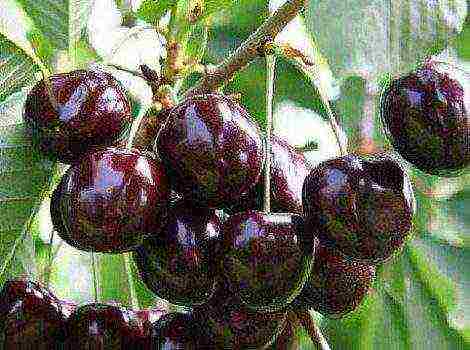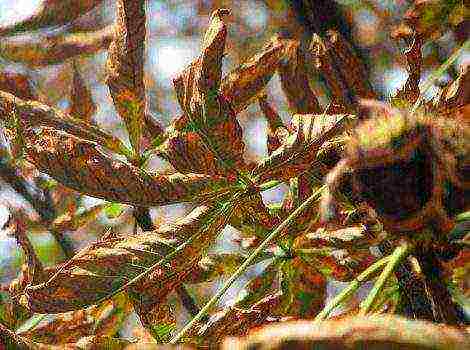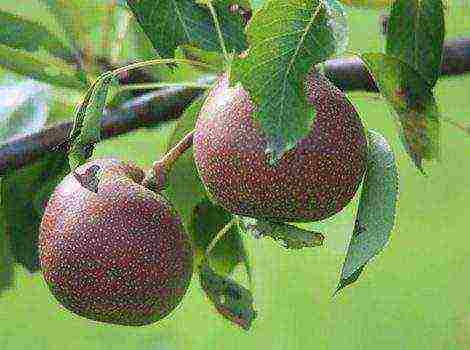How and when to prune a peach correctly?
Peach is a whimsical culture and requires increased attention. One of the main conditions for the successful cultivation of a peach garden is the correct formation of trees.
But any manipulation with the pruner must be performed correctly, in a timely manner and be justified. All the secrets of "green surgery" are in this material.
Is it possible and why to prune a peach tree?
Any garden culture is cutto increase the period of fruiting and yield. And the peach is also cut in order to increase its resistance to unfavorable climatic conditions.
From the method of forming the crown of a tree directly the winter hardiness of the plant depends... For example, a peach formed by a "spindlebush" ("spindle") will winter wonderfully in the south - in Cherkessk or Makhachkala, but already in the Krasnodar Territory, Rostov-on-Don may freeze. Here it is better to grow it with a "bowl".
In Central Russia, peach branches need to be lowered even lower and form a bush. And in more severe conditions, lay it horizontally - in the slate.
In addition to shaping, peaches are "prescribed" for regulating, restorative, rejuvenating and sanitary pruning.
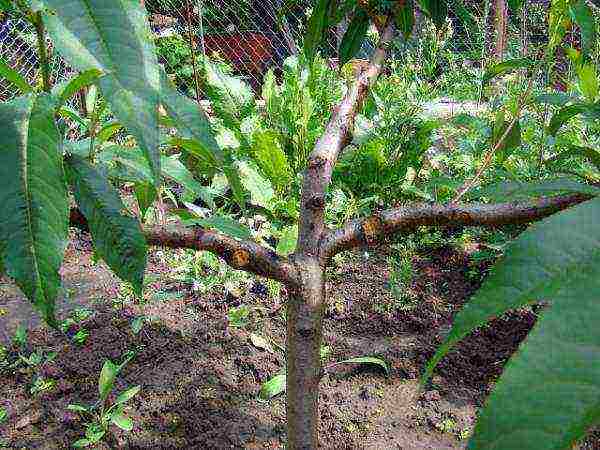
Choosing the right time: spring, summer or autumn?
Peach pruning begins from the 2nd year of life... By this time, the plant already "opens" - it has several lateral shoots. Future skeletal branches are selected from them.
It makes little sense to start pruning earlier. Sure, pinching the apex will stimulate the growth of lateral branches.
However, if too much is cut off, the shoots will go at an acute angle to the guide. It will take extra time to fix such a tree.
Peach belongs to crops that are pruned needed in spring, summer and autumn.
| Spring | Formation of the crown of the seedling. Restorative pruning with the removal of frozen shoots. Rejuvenating pruning of old trees. |
| Summer | Removing dead shoots unnoticed in spring. Shortening of weak fruit-bearing branches. Thinning "tops" and removal of thickening shoots. Sanitary pruning of shoots affected by diseases and pests. Shortening the growth of the current year for their better ripening. |
| Autumn | Sanitary pruning of diseased shoots. Removal of branches broken off by the crop. |
Experienced peach breeders recommend counting the branches remaining after the autumn pruning. There should be no more than eighty of them.
Summer, spring and autumn pruning scheme
It is important to choose the right time for pruning in any season.... Damp weather, rain, dew contribute to the penetration of infection into cuts and cuts. Therefore, the operation should be scheduled for a dry, clear day.
Minimum set of tools and materials for trimming includes:
- secateurs;
- lopper;
- garden knife;
- garden file;
- copper sulfate;
- garden putty.
Before the operation, the entire instrument must be disinfected with any fungicide or just boiling water, and then wiped dry.
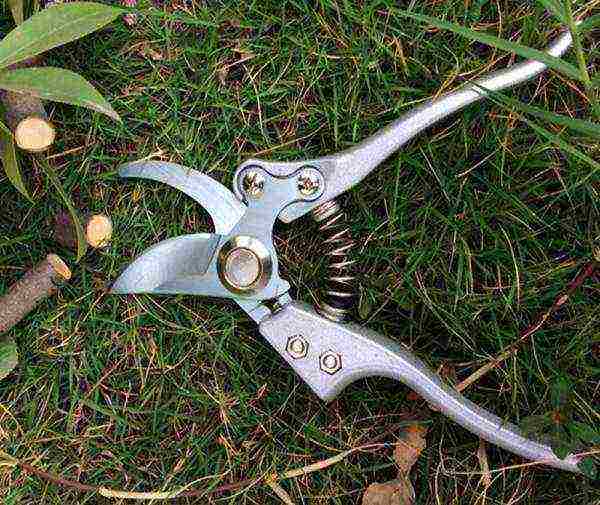
Spring peach pruning scheme:
- When forming a "bowl" of a two-year-old seedling, measure the height of the stem of about 50 cm.
- Three skeletal branches are identified, located at a large angle to the conductor and directed in different directions. They are shortened by 2 buds so that the upper one looks outward.
- The conductor is cut over the upper lateral branch. Excess shoots are removed on the ring.
- Overwintered shoots are examined in older trees. Broken and frozen ones are removed.
- To rejuvenate the peach, remove all branches with wood older than 4 years.
Spring peach pruning:
Summer peach pruning scheme:
- Examine the tree for any remaining dead shoots. If there are any, remove them.
- Examining the year-on-year increments. Those growing vertically upward or deep into the crown are removed.
- The remaining increments are pinched.
- Examine the fruit-bearing branches. If some weak and thin ones have tied a large crop, you need to shorten them, and thin out the ovaries.
- Diseased shoots are removed.
A new method for pruning peaches in summer to get bigger fruits:
Fall peach pruning scheme:
- Dry, diseased and broken branches are removed.
- Too long and thin shoots that did not have time to ripen are shortened by half.
- If root growth has appeared, it is cut out.
If a peach seedling was planted in the fall and did not survive the winter well, in the spring it can beat off lateral shoots from the lower dormant buds on the trunk.
In this case, shaping with a bush can be performed by cutting off the frozen central conductor at a height of 4-5 cm above the upper living kidney.
How to take care after the procedure?
After pruning, the peach must be cared for carefully. All wounds need to be treated... Many peach growers prefer to use oil paint instead of traditional garden varnish as a putty.
Slices covered with pitch sometimes rot due to moisture. Oil paint seals no worse, and does not cause decay. Same a good tool - RanNet paste.
For better drying, healing and disinfection before the putty, you can treat the wound with a 3% solution of copper sulfate... It is applied with a clean sponge and left for 1-1.5 hours. After that, use the garden putty.
How to crown and care for a peach:
Growing and care
In addition to regular pruning, the peach needs watering, fertilizing and treatments from pests and diseases.
| Spring | Top dressing | 0.5 liters of fermented mullein infusion in a 10-liter bucket of water. A week later - a liter can of wood ash. |
| Spraying | If last season the peach was heavily attacked by pests, the tree is sprayed with Calypso. Processing is carried out two times: on dormant buds and after flowering. During flowering, the insecticide can harm pollinators. | |
| Watering | With a small amount of melt water - 10 days before flowering. | |
| Summer | Top dressing | Foliar top dressing with a solution of Zdraven-Aqua for fruit trees complex fertilizer. |
| Spraying | If necessary, treatment with insecticides and fungicides. At the end of August - plantafol potassium foliar dressing to accelerate wood ripening. | |
| Watering | With a lack of natural precipitation, as the soil dries up, it is shed to a depth of 60 cm. Watering is stopped 2 weeks before the fruit is picked. | |
| Yield rationing | In the period of the beginning of fruit ripening, the ovaries are examined and the tree's ability to "bear and feed" them is assessed. If there are too many ovaries, thinning should be done. | |
| Autumn | Top dressing | Only phosphate-potassium fertilizers. Nitrogen is excluded. |
| Watering | Water-charging irrigation is required. Leaving a peach for wintering in dry soil is unacceptable - the root system freezes out. | |
| Preparing for winter | Whitewash the stem with Gardener lime paste. In severe winters with little snow - the creation of additional dry shelters: reed or corn huts, agrospan caps. |
Mandatory peach care activities also include constant care of the near-trunk circle: weeding, loosening, mulching with a thick layer of organic matter: chopped bark, lying sawdust, mowed grass, mature compost.
It is better not to use hay as mulch. - rodents like to settle in it.
Mulching avoids the need for frequent watering, even in dry summers, preventing moisture evaporation and soil crust formation. Organic mulch will provide the plant with nitrogen and carbon dioxide when decomposed.

Summer grafting, budding: how to graft a peach on a plum, an apricot, etc.
Another important "green operation" can be peach grafting. The need for it appears in cases where:
- it was a harsh winter, the wood was frozen, but the root is alive;
- the tree has been badly broken off by winds, snow, or a bountiful harvest;
- the variety is self-fertile, a pollinator is needed, but there is no place for planting it;
- there is a suitable seedling for the stock and a desire to propagate a favorite variety.
Suitable as a rootstock for peach bitter almonds, wild apricots, Manchu peaches, wild cherry plums. If there is none of this on the site, you can plant a peach on a plum - these crops have good compatibility.
Budding is done in the crown of the stock or on the stem of a young seedling according to this scheme:
- An actively growing green shoot is cut from a suitable plant. All leaves are removed from it, but petioles are left.
- A good bud is selected from the middle part of the shoot and the “shield” is cut off - a section of the bark with the cambium and the bud itself. The length of the shield is about 2.5-3 cm.
- On the rootstock, the bark is cut in a T-shape and bent slightly to the sides. You do not need to touch the cambium.
- The scutellum is inserted into the incision, covered with bark so that the kidney remains outside.
- Winding is carried out from the bottom up in a spiral, bypassing the kidney.
You can wrap the vaccination site with the back (non-adhesive) side of ordinary electrical tape or tape.
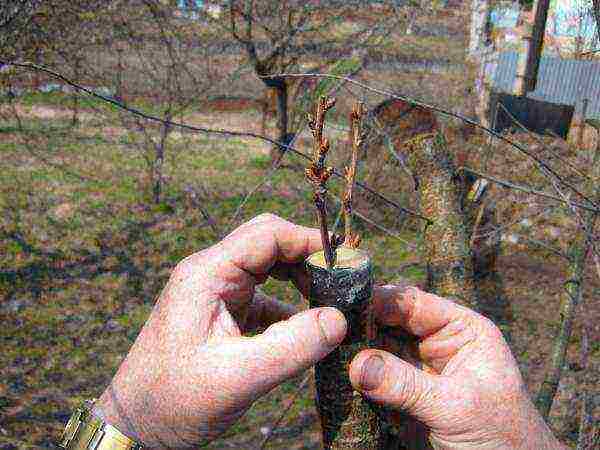
After 7-10 days by the state of the petiole, it is judged whether the peephole is engrafted. If the petiole turns yellow and falls off from touching with a finger, the kidney has taken root. If blackened and rotted, the vaccination has failed.
In case of success, after 1-2 months you can remove the winding... If the grafting was carried out in a bole, it will be correct to huddle the tree high for the winter. So it will be possible to protect the kidney from freezing or damage by rodents.
In the spring, the earth is raked off, and the vaccination site is treated with 3% Bordeaux liquid.
Peach budding:
To make the peach feel good and bear fruit abundantly, caring for him should be comprehensive and regular... This culture does not forgive laziness and neglect, but rewards effort with beautiful, fragrant fruits.
